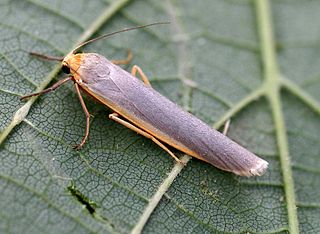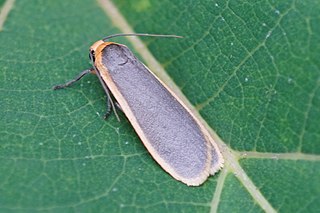
The common footman is a moth of the family Erebidae. The species was first described by Johann Leopold Theodor Friedrich Zincken in 1817. It is distributed throughout Europe and east through the Palearctic to Lake Baikal.

Manulea complana, the scarce footman, is a moth of the family Erebidae. The species was first described by Carl Linnaeus in his 1758 10th edition of Systema Naturae. It is found throughout the Palearctic region.

Eilema caniola, the hoary footman, is a moth of the family Erebidae. The species was first described by Jacob Hübner in 1808.

Manulea is a genus of moths in the family Erebidae erected by Hans Daniel Johan Wallengren in 1863. The type species is Lithosia gilveola Ochsenheimer, 1810.

Watsonarctia is a monotypic moth genus in the subfamily Arctiinae erected by Josef J. de Freina and Thomas Joseph Witt in 1984. Its only species, Watsonarctia deserta, the chaste pellicle, was first described by Max Bartel in 1902. It is found in central and south-eastern Europe, southern Russia, southern Siberia east to Lake Baikal; also in Asia Minor, Armenia, Azerbaijan, northern Iran, Kazakhstan, Kyrghyzstan and Xinjiang in China.
Manulea pseudocomplana is a moth of the family Erebidae. It is found from central and southern Europe to Ukraine, Turkey and Iran.

Manulea pygmaeola, the pigmy footman, is a moth of the family Erebidae. It is found in the western half of the Palearctic realm, east to Altai.

Manulea (Setema) cereola is a moth of the family Erebidae. It is found in Fennoscandia, the Baltic States, European Russia as well as the Alps and Urals. The species was first described by Jacob Hübner in 1803.
Manulea costalis is a moth of the family Erebidae. It is found in Albania, Bulgaria, Serbia, North Macedonia, Greece and on Crete, as well as in Turkey and Armenia. on the Andamans and from India to Myanmar.
Manulea flavociliata is a moth of the family Erebidae. It is found in north-eastern Kazakhstan, southern Siberia, the Russian Far East, Mongolia, China and Korea.
Manulea minor is a moth of the family Erebidae. It is found in the Russian Far East and Japan.
Manulea affineola is a moth of the family Erebidae. It is found in the Russian Far East (Primorye), Korea, China (Shaanxi) and Japan.

Manulea japonica is a moth of the family Erebidae. It is found on the Kuril Islands (Kunashir) and in China, Korea and Japan. It has a wingspan of 25–30 mm.
Manulea nankingica is a moth of the family Erebidae first described by Franz Daniel in 1954. It is found in the Russian Far East (Primorye), China (Jiangsu), Korea and Japan.
Manulea ussurica is a moth of the family Erebidae. It is found in the Russian Far East (Primorye), China and Korea.
Manulea wiltshirei is a moth of the family Erebidae. It is found in south-western Asia, including Lebanon.
Manulea atratula is a moth of the family Erebidae. It is found in Russia, Mongolia and North Korea.

Manulea bicolor, the bicolored moth or yellow-edged footman, is a moth of the family Erebidae. It is found in boreal North America, from Labrador and Massachusetts to Yukon and British Columbia. In the Rocky Mountains, it ranges south to southern Colorado. The habitat consists of boreal forests, parklands and riparian cottonwoods in the prairies.
Manulea nigrocollare is a moth of the family Erebidae. It is found in Russia.
This page is based on this
Wikipedia article Text is available under the
CC BY-SA 4.0 license; additional terms may apply.
Images, videos and audio are available under their respective licenses.








